
Sphaeralcea is a genus of flowering plants in the mallow family (Malvaceae). There are about 40-60 species, including annuals, perennials, and shrubs. Most originate in the drier regions of North America, with some known from South America. They are commonly known as globemallows, globe mallows, false mallows or falsemallows. The name of the genus is derived from the Greek words σφαῖρα (sphaira), meaning "sphere," and αλκεα (alkea), meaning "mallow."

Toxicoscordion venenosum, with the common names death camas and meadow death camas, is a species of flowering plant in the family Melanthiaceae. It is named for its well known toxic qualities, with both its common names and its scientific name referencing this. Because its nectar is also poisonous, it is mainly pollinated by the death camas miner bee, which specializes in collecting the toxic pollen for its young. It is native to western North America from New Mexico to Saskatchewan and west to the Pacific Ocean.

Heuchera is a genus of largely evergreen perennial plants in the family Saxifragaceae. All species are native to North America except for Heuchera sichotensis, native to the Russian Far East. Common names include alumroot and coral bells.
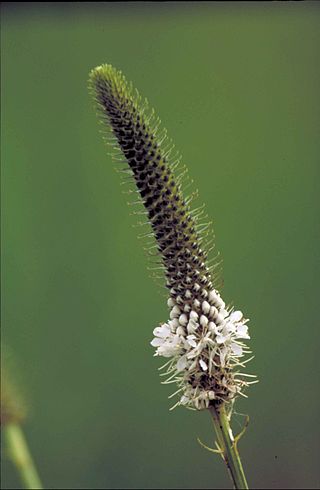
Dalea is a genus of flowering plants in the legume family, Fabaceae. Members of the genus are commonly known as prairie clover or indigo bush. Its name honors English apothecary Samuel Dale (1659–1739). They are native to the Western hemisphere, where they are distributed from Canada to Argentina. Nearly half of the known species are endemic to Mexico. Two species of Dalea have been considered for rangeland restoration.
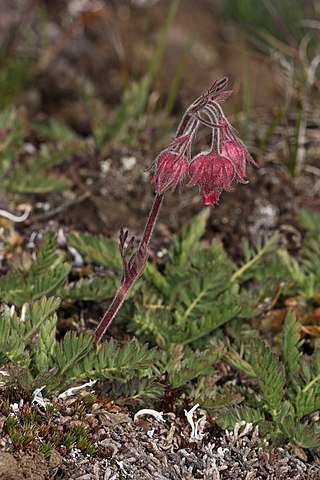
Geum triflorum, commonly known as prairie smoke, old man's whiskers, torchflower, three-sisters, long-plumed purple avens, lion's beard, or three-flowered avens, is a spring-blooming perennial herbaceous plant of the Rosaceae family. It is a hemiboreal continental climate species that is widespread in colder and drier environments of western North America, although it does occur in isolated populations as far east as New York and Ontario. It is particularly known for the long feathery plumes on the seed heads that have inspired many of the regional common names and aid in wind dispersal of its seeds.
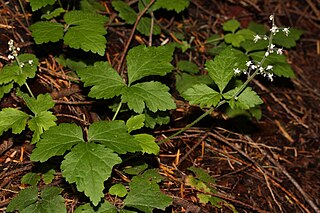
Tiarella trifoliata, the three-leaf foamflower, is a species of flowering plant in the family Saxifragaceae. The specific name trifoliata means "having three leaflets", a characteristic of two of the three recognized varieties. Also known as the laceflower or sugar-scoop, the species is found in shaded, moist woods in western North America.

Perityle is a genus of flowering plants in the daisy family. They are known generally as rock daisies.

Symphyotrichum lateriflorum is a species of flowering plant in the aster family (Asteraceae). Commonly known as calico aster, starved aster, and white woodland aster, it is native to eastern and central North America. It is a perennial and herbaceous plant that may reach heights up to 120 centimeters and widths up to 30 centimeters.

Astragalus lentiginosus Astragalus lentiginosus is a species of legume native to western North America where it grows in a range of habitats. Common names include spotted locoweed and freckled milkvetch. There are a great number of wild varieties. The flower and the fruit of an individual plant are generally needed to identify the specific variety.

Laphamia inyoensis, known by the common names Inyo rockdaisy and Inyo laphamia, is a rare species of flowering plant in the aster family.
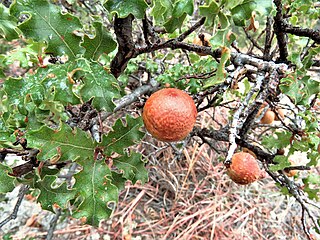
Quercus pungens, commonly known as the sandpaper oak or scrub oak, is a North American species evergreen or sub-evergreen shrub or small tree in the white oak group. There is one recognised variety, Quercus pungens var. vaseyana, the Vasey shin oak. Sandpaper oak hybridizes with gray oak in the Guadalupe Mountains of New Mexico and Texas.
Laphamia saxicola is a rare species of flowering plant in the aster family known by the common names Roosevelt Dam rockdaisy and Fish Creek rockdaisy. It is endemic to Arizona in the United States, where it occurs in Tonto National Monument near the Roosevelt Dam.

Tetraneuris acaulis is a North American species of flowering plants in the sunflower family. It is known by many common names in English including stemless four-nerve daisy, stemless hymenoxys, butte marigold, and stemless rubberweed.
Galinsogeopsis is a genus of flowering plants in the family Asteraceae. It includes 18 species native to Mexico and the southwestern United States, ranging from Arizona, New Mexico, and Texas to southern Mexico.
Laphamia is a genus of flowering plants in the sunflower family, Asteraceae. It includes 43 species native to the southwestern and south-central United States and northern and western Mexico.
Heterotheca stenophylla, called the stiffleaf goldenaster, is a North American species of flowering plant in the family Asteraceae. It grows on the Great Plains of the central United States from South Dakota south to Texas and New Mexico.

Heterotheca villosa, commonly known as the hairy goldenaster, is a species of flowering plant in the family Asteraceae found in central and western North America.
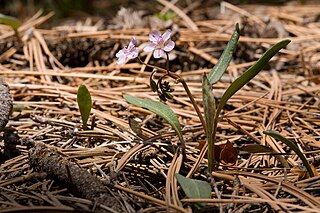
Claytonia rosea, commonly called Rocky Mountain spring beauty, western springbeauty or Madrean springbeauty, is a diminutive spring blooming ephemeral plant with pale pink to magenta flowers. It grows a small round tuberous root and it one of the earliest wildflowers of spring in its range. It is found in dry meadows in forests of ponderosa and Chihuahuan pines, and moist ledges of mountain slopes of the Beaver Dam Mountains of Utah, Colorado Front Range, and Sierra Madre Occidental, south and east to the Sierra Maderas del Carmen of Coahuila.

Laphamia fosteri is an endangered species of flowering plant endemic to Culberson County, Texas. It is found along limestone canyons in the Apache Mountains, an offshoot of the Guadalupe Mountains.















